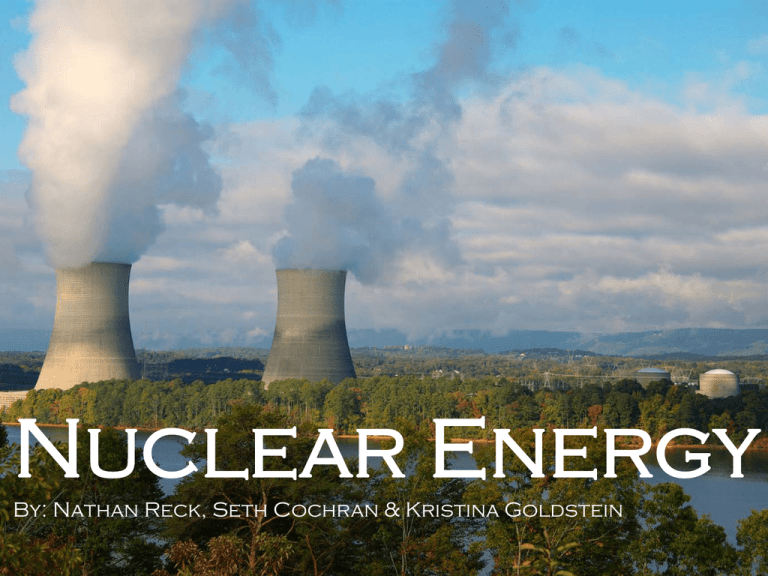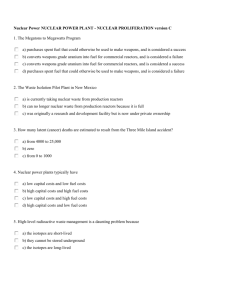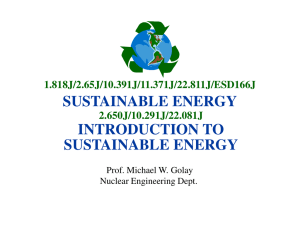By: Nathan Reck, Seth Cochran & Kristina Goldstein
advertisement

By: Nathan Reck, Seth Cochran & Kristina Goldstein Overview Basics of Nuclear Energy Reactor Design Sustainability Waste Generation: Comparison of Reactor Designs Issues with Disposal Costs Economic Land Environmental Time Conclusions Basic Reactor Design Sustainability less than 1% of uranium isotopes 441 reactors in 30 countries 235U 14% of world’s electricity ~ 25 year lifespan Minimal replacement of old reactors Operated at full capacity Uranium is nonrenewable Uranium Resources Sources of Uranium 51,000 tons mined in 2009 … but use about 68,000 ton/year The rest comes from reserves 200,000 and 300,000 tons estimated in the US and Russia Collected from 1950- 1990, primarily during the Cold War Level or quantity of enrichment is unknown Several New Mines Estimated total peak in 2035 with 98,000 – 141,000 tons/year Possibility of Recycling some fuel Consequences Nonrenewable source Nuclear Energy is a sign of transition into modern society Developing countries such as China and India are investing in nuclear energy A potential financial disaster if not enough 235U to fill reactor… Europe leads in % of electricity from nuclear power plant Unfortunately, Europe is furthest away form uranium mines USA and Western Pacific countries are closer to mines Militaries would take uranium first if there becomes a shortage Submarines Nuclear deterrence Waste Generation per Year USA generates ~2,000 metric tonnes of high-level waste per year. Over ~60 years ~70,000 metric tonnes of high-level waste has been created Recycling Used Nuclear Fuel Currently the United States does not recycle used nuclear fuel – “once-through” open fuel cycle The industry supports research, development and demonstration of improved or advanced fuel cycle technologies Goal is to close the nuclear fuel cycle Potentially reducing Waste volume Heat and toxicity of byproducts Open Fuel Cycle – Once Through Close Fuel Cycle – One Recycle Close Fuel Cycle – Full Recycle The Costs of Nuclear Energy Four main costs are: Financial Land Time Emissions Costs: Economic High initial cost for construction Consumers pay more at the beginning Low ongoing costs due to routine maintenance and intermittent refueling Costs more to build a new reactor versus updating a current reactor Cost: Land Buffer zone needed for safety U.S. divides plants into an owner-controlled buffer region (area restricted to some plant employees and monitored visitors) and a vital area with more restrictions Needed for uranium mining and waste disposal Grand total for one plant: 20.5 km2 (7.88 mi2 ) Nuclear Waste Fund $ 25,000,000,000 that is unspent Collecting $750,000,000 per year in fee revenues from utility plants until 2013 Cost: Environmental Due to uranium mining, enrichment, transport, and waste disposal Also due to construction, operation, and decommissioning of the reactors Opportunity-cost from emissions: the more time that passes, more emissions will be released Cost: Time Time in between planning and operation of a technology includes the time to site, finance, permit, insure, construct, license, and connect technology to utility grid 6-10 years for approvals and financing 4-9 to construct plant and connect to utility grid Issues such as inflation and more stringent safety regulations, especially after accidents, cause the increase in time to build and finance Conclusions Nuclear energy provides a cleaner alternative to coal Significant reduction of CO2 emissions Still an nonrenewable resource Waste disposal and storage are still unresolved issues Closing the fuel cycle can dramatically improve yield and reduce waste Once Through vs One Recycle vs Full Recycle Cost: Higher upfront capital cost Lower operating costs Significantly lower environmental cost (emissions) Resources Dittmar, M. Nuclear energy: Status and future limitations. Energy 2012, 37, 35-40. DeRosa, Tom. "Nuclear: Is It Clean and Green?" Renewable Energy World. RenewableEnergyWorld.com, 11 Feb. 2015. Web. 23 Apr. 2015. http://www.nature.com/scientificamerican/journal/v298/n5/box/scientificamerican050 8-88_BX1.html Wydler, Peter, and Leo Baetsle. CLOSING THE NUCLEAR FUEL CYCLE: ISSUES AND PERSPECTIVES. Tech. N.p.: n.p., n.d. Print. Deutch, John, Ernest J. Moniz, et al. 2003. The Future of Nuclear Power—An Interdisciplinary MIT Report. Massachusetts Institute of Technology. See http://web.mit.edu/nuclearpower/ Jacobson, M.Z. Review of solutions to global warming, air pollution, and energy security. Energy Environ. Sci., 2009, 2, 148–173. http://instituteforenergyresearch.org/analysis/electric-generating-costs-a-primer/ http://www.world-nuclear.org/info/Country-Profiles/Countries-T-Z/USA--NuclearPower/ http://theenergycollective.com/schalk-cloete/448701/can-nuclear-make-substantialnear-term-contribution





